Abstract
The nucleotides ppGpp and pppGpp accumulate when wild-type, but not rel-, strains of Escherichia coli are starved for required amino acids. These compounds are synthesized on ribosomes, in the presence of the product of the rel gene, from GDP and GTP; ATP is used as the phosphate donor. The signal for making these compounds is the presence of an uncharged tRNA in the ribosomal acceptor site. These compounds are not accumulated if the ribosomes are actively engaged in protein synthesis.
Keywords: stringent control, ppGpp (MSI) and pppGpp (MSII), protein synthesis, Escherichia coli
Full text
PDF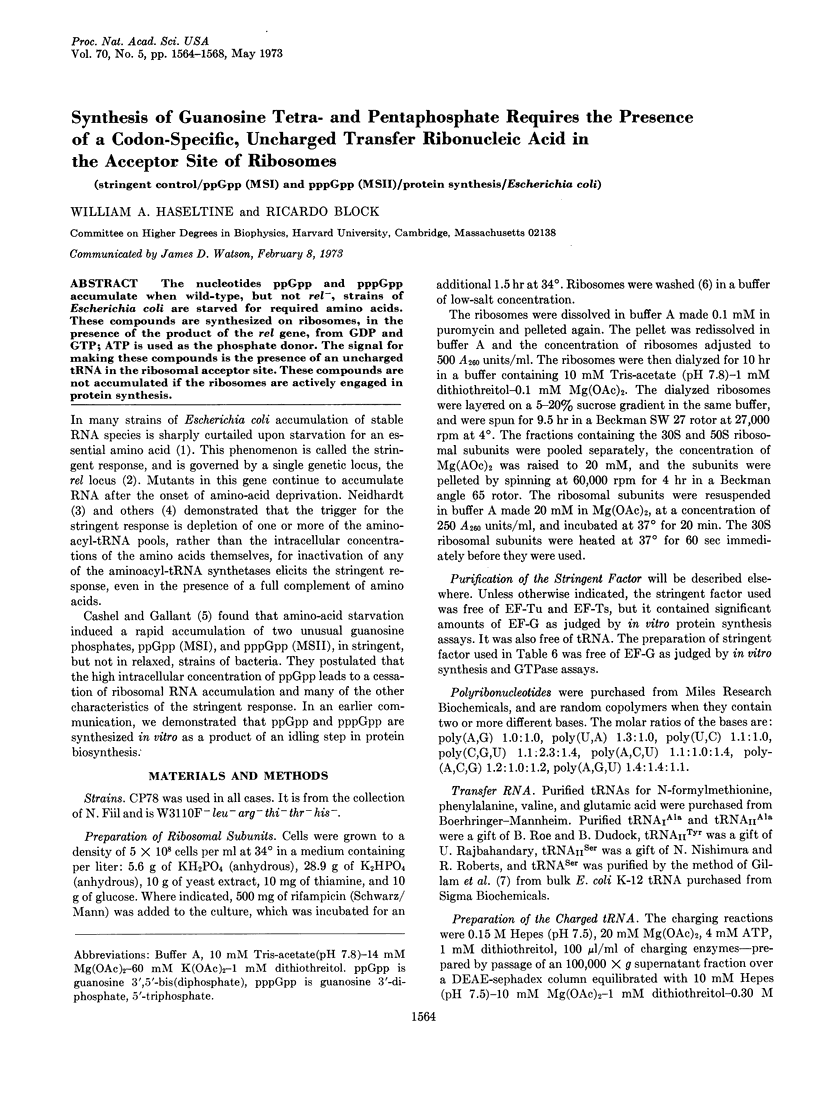
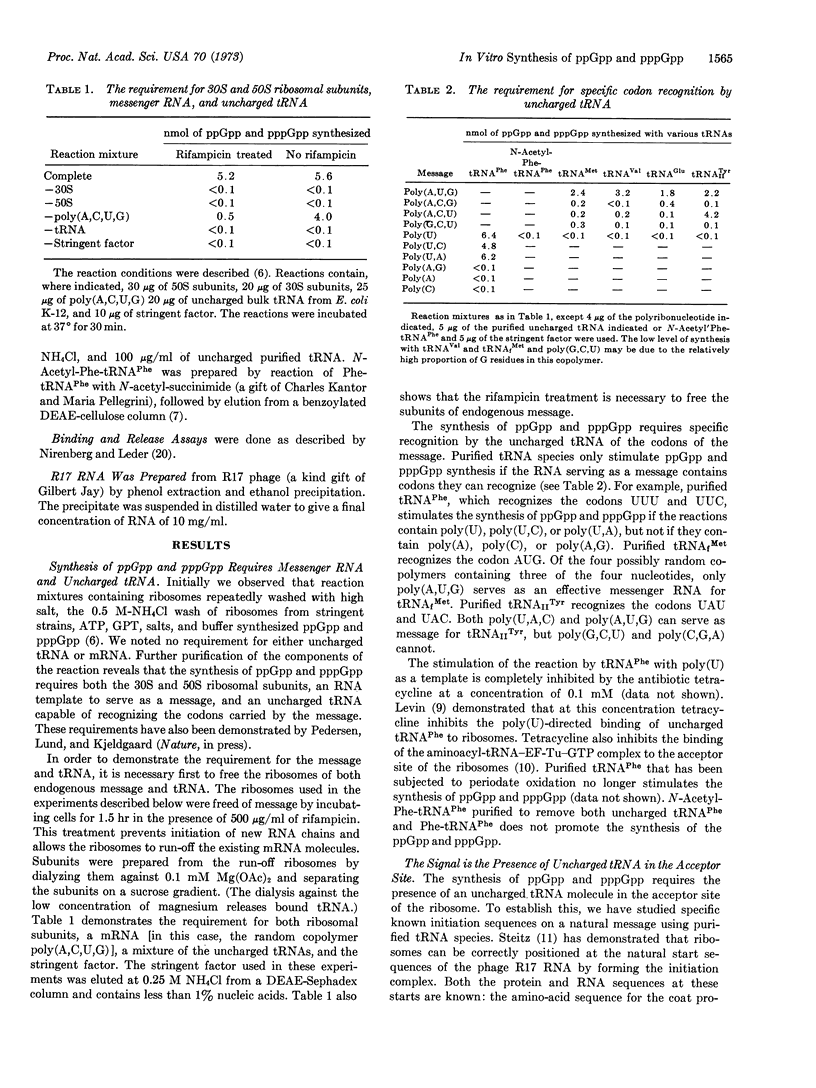
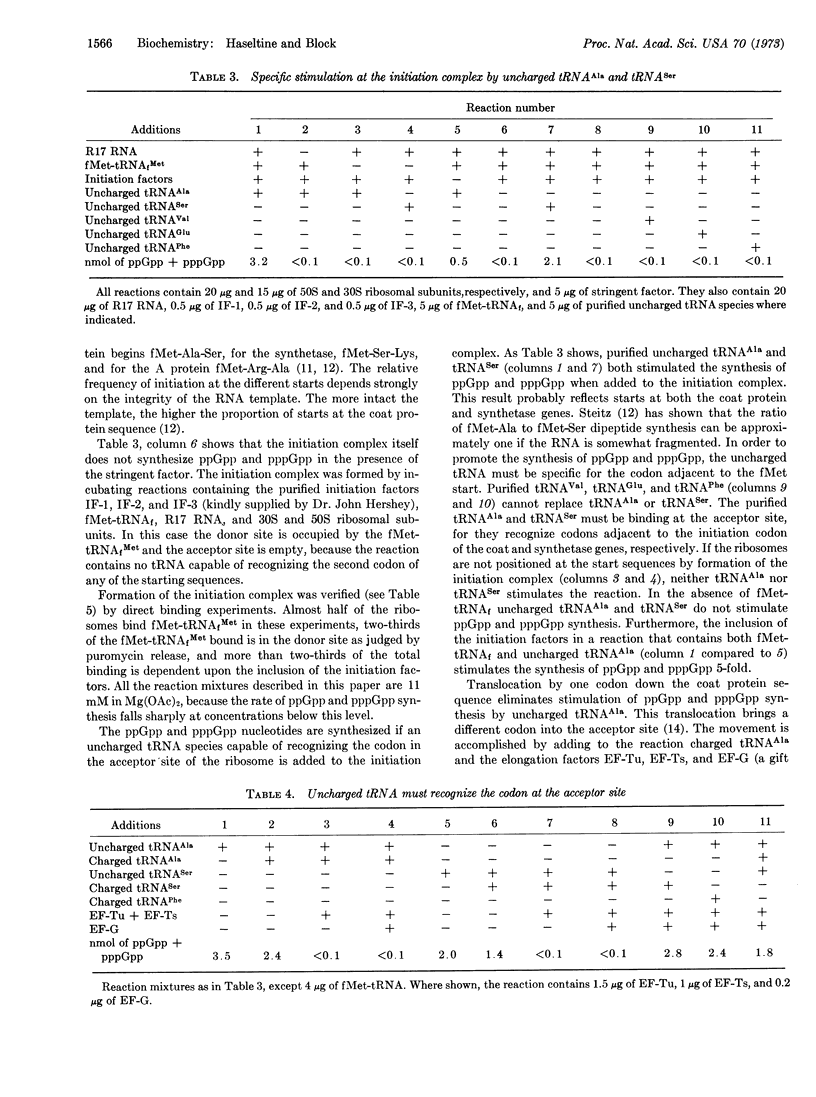
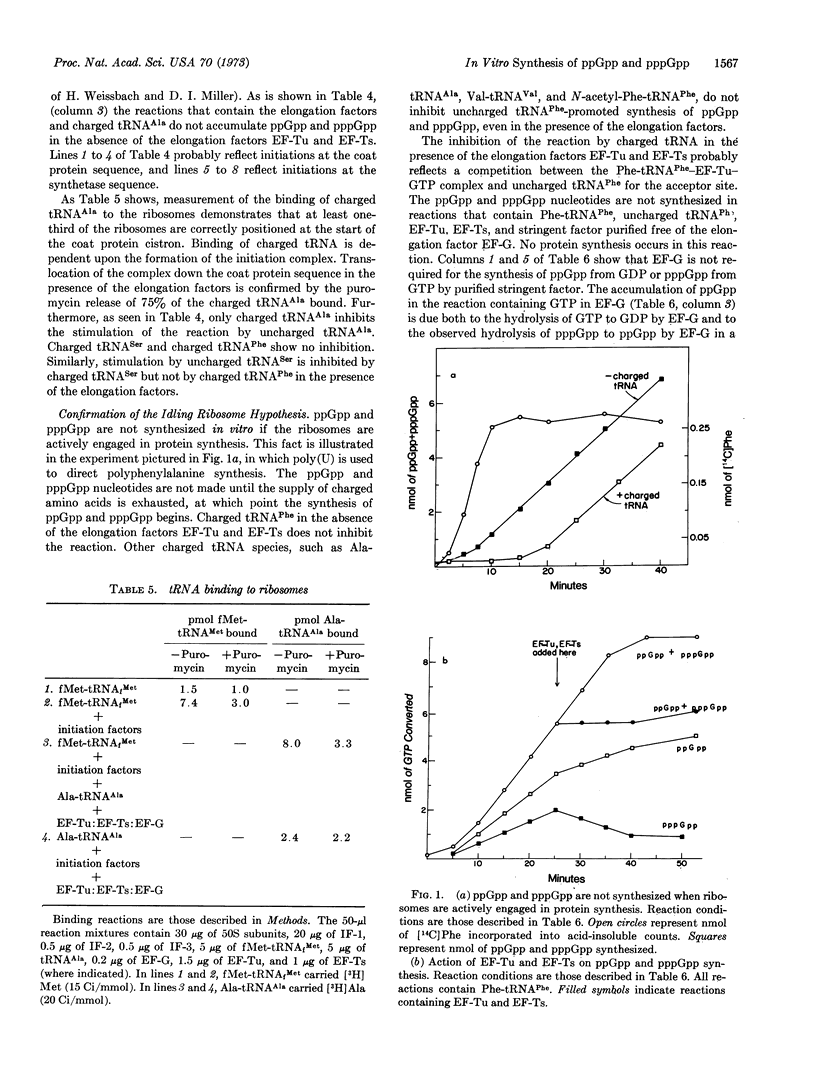
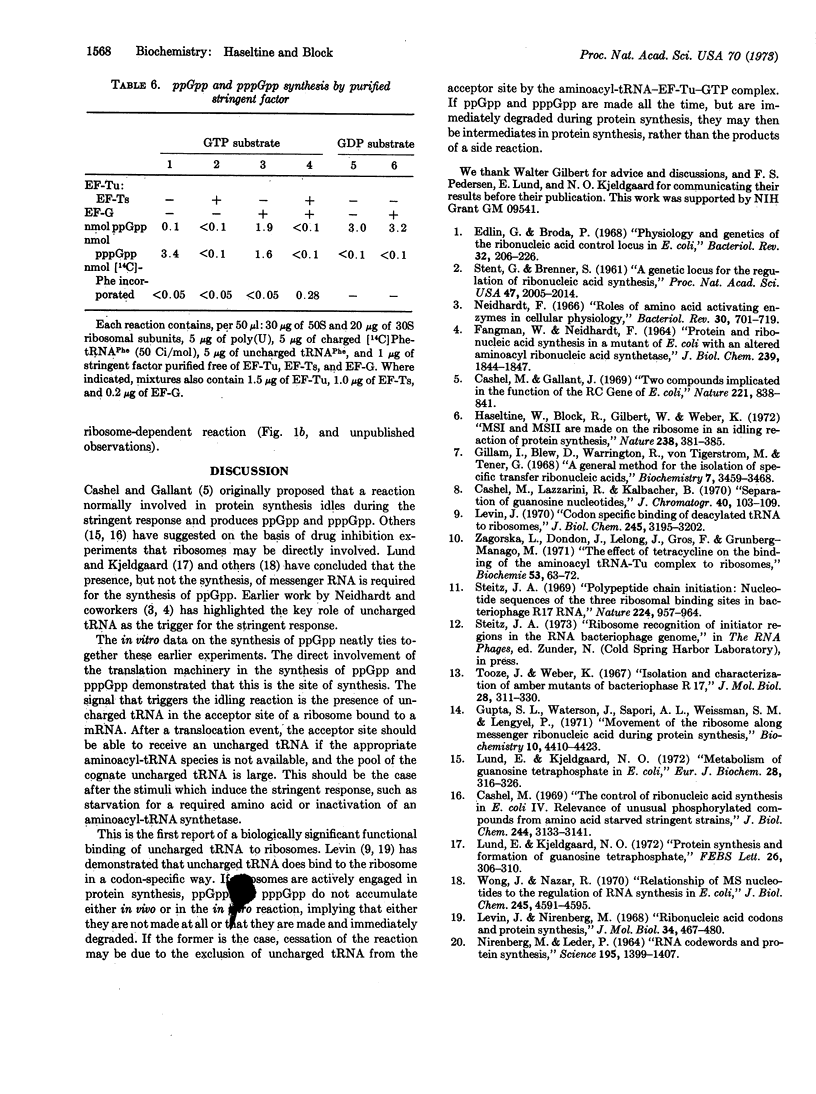
Selected References
These references are in PubMed. This may not be the complete list of references from this article.
- Cashel M., Gallant J. Two compounds implicated in the function of the RC gene of Escherichia coli. Nature. 1969 Mar 1;221(5183):838–841. doi: 10.1038/221838a0. [DOI] [PubMed] [Google Scholar]
- Cashel M., Lazzarini R. A., Kalbacher B. An improved method for thin-layer chromatography of nucleotide mixtures containing 32P-labelled orthophosphate. J Chromatogr. 1969 Mar 11;40(1):103–109. doi: 10.1016/s0021-9673(01)96624-5. [DOI] [PubMed] [Google Scholar]
- Cashel M. The control of ribonucleic acid synthesis in Escherichia coli. IV. Relevance of unusual phosphorylated compounds from amino acid-starved stringent strains. J Biol Chem. 1969 Jun 25;244(12):3133–3141. [PubMed] [Google Scholar]
- Edlin G., Broda P. Physiology and genetics of the "ribonucleic acid control" locus in escherichia coli. Bacteriol Rev. 1968 Sep;32(3):206–226. doi: 10.1128/br.32.3.206-226.1968. [DOI] [PMC free article] [PubMed] [Google Scholar]
- FANGMAN W. L., NEIDHARDT F. C. PROTEIN AND RIBONUCLEIC ACID SYNTHESIS IN A MUTANT OF ESCHERICHIA COLI WITH AN ALTERED AMINOACYL RIBONUCLEIC ACID SYNTHETASE. J Biol Chem. 1964 Jun;239:1844–1847. [PubMed] [Google Scholar]
- Gillam I., Blew D., Warrington R. C., von Tigerstrom M., Tener G. M. A general procedure for the isolation of specific transfer ribonucleic acids. Biochemistry. 1968 Oct;7(10):3459–3468. doi: 10.1021/bi00850a022. [DOI] [PubMed] [Google Scholar]
- Gupta S. L., Waterson J., Sopori M. L., Weissman S. M., Lengyel P. Movement of the ribosome along the messenger ribonucleic acid during protein synthesis. Biochemistry. 1971 Nov 23;10(24):4410–4421. doi: 10.1021/bi00800a010. [DOI] [PubMed] [Google Scholar]
- Haseltine W. A., Block R., Gilbert W., Weber K. MSI and MSII made on ribosome in idling step of protein synthesis. Nature. 1972 Aug 18;238(5364):381–384. doi: 10.1038/238381a0. [DOI] [PubMed] [Google Scholar]
- Levin J. G. Codon-specific binding of deacylated transfer ribonucleic acid to ribosomes. J Biol Chem. 1970 Jun;245(12):3195–3202. [PubMed] [Google Scholar]
- Levin J. G., Nirenberg M. Ribonucleic acid codons and protein synthesis. 13. RNA codon recognition by deacylated tRNA and aminoacyl-tRNA. J Mol Biol. 1968 Jun 28;34(3):467–480. doi: 10.1016/0022-2836(68)90173-3. [DOI] [PubMed] [Google Scholar]
- Lund E., Kjeldgaard N. O. Metabolism of guanosine tetraphosphate in Escherichia coli. Eur J Biochem. 1972 Jul 24;28(3):316–326. doi: 10.1111/j.1432-1033.1972.tb01916.x. [DOI] [PubMed] [Google Scholar]
- Lund E., Kjeldgaard N. O. Protein synthesis and formation of guanosinetetraphosphate. FEBS Lett. 1972 Oct 1;26(1):306–310. doi: 10.1016/0014-5793(72)80599-4. [DOI] [PubMed] [Google Scholar]
- NIRENBERG M., LEDER P. RNA CODEWORDS AND PROTEIN SYNTHESIS. THE EFFECT OF TRINUCLEOTIDES UPON THE BINDING OF SRNA TO RIBOSOMES. Science. 1964 Sep 25;145(3639):1399–1407. doi: 10.1126/science.145.3639.1399. [DOI] [PubMed] [Google Scholar]
- Neidhardt F. C. Roles of amino acid activating enzymes in cellular physiology. Bacteriol Rev. 1966 Dec;30(4):701–719. doi: 10.1128/br.30.4.701-719.1966. [DOI] [PMC free article] [PubMed] [Google Scholar]
- STENT G. S., BRENNER S. A genetic locus for the regulation of ribonucleic acid synthesis. Proc Natl Acad Sci U S A. 1961 Dec 15;47:2005–2014. doi: 10.1073/pnas.47.12.2005. [DOI] [PMC free article] [PubMed] [Google Scholar]
- Steitz J. A. Polypeptide chain initiation: nucleotide sequences of the three ribosomal binding sites in bacteriophage R17 RNA. Nature. 1969 Dec 6;224(5223):957–964. doi: 10.1038/224957a0. [DOI] [PubMed] [Google Scholar]
- Tooze J., Weber K. Isolation and characterization of amber mutants of bacteriophage R17. J Mol Biol. 1967 Sep 14;28(2):311–330. doi: 10.1016/s0022-2836(67)80012-3. [DOI] [PubMed] [Google Scholar]
- Wong J. T., Nazar R. N. Relationship of the MS nucleotides to the regulation of ribonucleic acid synthesis in Escherichia coli. J Biol Chem. 1970 Sep 10;245(17):4591–4593. [PubMed] [Google Scholar]


